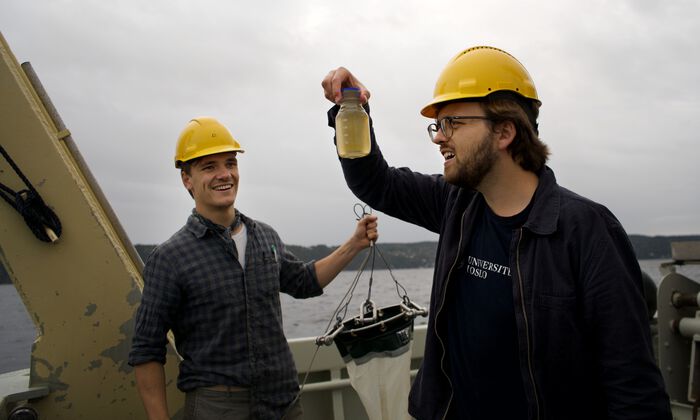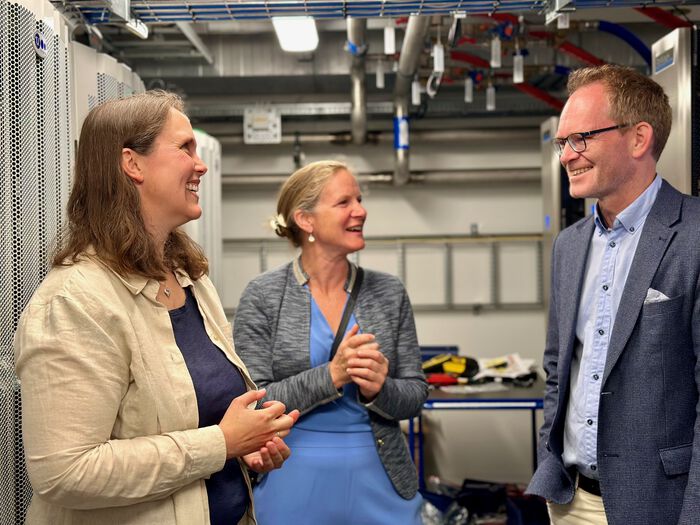This article is written together with professor Knut Mørken at Center of Mathematics for Applications (CMA). Knut is also one of the key persons behind the CSE-project (CSE=Computing in Science Education) at the Faculty of Mathematics and Natural Sciences. Another bloggposts about the CSE-project you can find here (in Norwegian). Earlier this year the CSE-project got "The Nation Prize on Education Quality" awarded by NOKUT (in Norwegian).
Background
Computations have always been an essential tool, both in mathematics and in the natural sciences, and the digital computer was originally developed for the purpose of performing scientific calculations. At most universities, the first computers were constructed or obtained for specific scientific calculations. Over the years, computer simulations or computations have become fundamental tools in research and industry across the world. In spite of this, the elementary science teaching at most universities is still focused around pencil-and-paper calculations, usually supplemented with the use of calculators to do many of the classical computations. A consequence is that it is difficult to expose the students at the elementary level to practical problems considered in research and industry. At the University of Oslo we believe that both mathematics and science education should include a definite computational component right from the first semester, as a supplement and complement to the classical material. In this way the students get a thorough training both in classical and computational methods and may study relevant problems form research and industry from very early in their undergraduate studies. The project “Computing in Science Education” (CSE) was launched about ten years ago to implement a computational perspective at the University of Oslo. This article will provide a short report on the project.
Overall purpose and benefits
The overall aim of the CSE-project has been to supplement the student’s mathematical toolbox with computational methods and programming. The core of this is to train the students in algorithmic problem solving as well as the classical mathematical techniques. This includes discussion of well-known numerical techniques with both their potential and limitations, but also an understanding of how new numerical methods may be developed. And it includes widespread exposure to how such tools may be used to explore science and mathematics. Although numerical procedures are often very simple, they nevertheless require a fundamental shift in the students’ thinking. As an example, consider solution of equations. Most students come to university with the deep-rooted understanding that solving an equation is synonymous with finding a formula for the solution. By using an algorithmic approach, arbitrarily close approximations to the solution may be obtained quickly through numerical techniques. It turns out that this way of thinking of solutions does not come easy for many students. But the benefits are clear: Instead of the limited classes of equations that can be solved by formula, most equations encountered in practice may be solved via an algorithmic approach. Some of the pedagogical benefits of computationally oriented education are:
- An algorithmic approach may help to increase the understanding of mathematics and science.
- Simulation using computer programs moves the attention from intricate mathematical details with pencil and paper to a greater focus on problem formulation and the physical behaviour of systems and phenomena.
- Numerical solutions allow much more realistic and inspiring problems to be addressed, and give students a taste of what scientific and industrial problems are about.
Organisational implementation and collaboration
A particular achievement of the CSE-project at the University of Oslo is that we have managed to implement the computer-based methods by modifying existing science courses, in contrast to the more common approach where modernization is taken care of in new programs in computational science with separate courses. The goal has been to develop a unified computational perspective on undergraduate teaching programmes across courses and science disciplines. This is difficult to accomplish without some cross-disciplinary understanding among teachers in order to align courses across disciplines. At the University of Oslo this was partly provided by some local experimentation with computational oriented teaching more than ten years ago. But the most important catalysts was the introduction of broad bachelor programmes via a major educational reform in 2003, and the introduction of the centre of excellence Centre of Mathematics for Applications, also in 2003. Both these events required quite thorough discussions between scientific staff in order to initiate the broad teaching cooperation necessary to implement the program. The next important step was to obtain necessary support from governing bodies. This was secured by asking for support from the Dean of the Faculty of Mathematics and Natural Sciences that incorporated the CSE-project as a major task in the Faculty’s strategic plan. The Faculty also supported the project with administrational expertise, and a steering group was formed which included teaching staff, the Dean of Education, and the Head of the Faculty’s Section for Education. The success of the CSE-project has to a large extent depended on the work of the latter two. When the atmosphere for collaboration is in place, and there is enough support from the leadership, it is possible to revise the teaching programmes with an emphasis on how they function as a whole, not just each individual course. This requires relatively broad agreement on the direction of the reform, and how it can be implemented across disciplines, but at the same time remembering that each teacher must be allowed the freedom to implement the ideas in a way that he or she believes in.
Lessons and experiences
The points raised above are all quite generic to broad revisions of teaching programmes, but the CSE-project is a reform that focuses on new content. Over the years we have learnt some important lessons: New understanding of mathematics and science. The students come to university with a set idea of what mathematics is, and what science is. For most students, the integration of programming and computer calculations into mathematics and science challenges these ideas, and causes confusion in the beginning. It is therefore important to explain why this integration is necessary, and not underestimate the difficulties for the students. Classical theory is still important. Some may think that calculations by computer may reduce the need for classical mathematics and science. In fact, the opposite is true. Development of algorithms and algorithmic thinking requires a unified and abstract view of mathematics, and therefore many students find computations difficult. A strong foundation in classical mathematics is therefore beneficial. The same applies to other scientific disciplines. In order to derive computational models, it is absolutely essential to be confident within the general theory. Understanding, not black box. For a teacher, it may be tempting to develop flashy software that demonstrates what can be achieved by combining computers, mathematics and graphics. This may have its place as a kind of advanced figures, but keep in mind that the goal is to create understanding. Most students will learn much more from writing a program that draws a very simple figure rather than being presented with flashy version of the same figure, produced by someone else. Integrate rather than add on. The natural approach when introducing computations in a course is to start with the existing course and add computations. This naturally leads to the common objection ‘there is no room for computations in my course’. If instead computations are integrated into the different parts of the syllabus it takes up much less space. In mathematics for example it is often possible to make use of numerical methods and examples in the development of the theory, and in this way the students learn numerical methods and theory simultaneously. However, this requires new textbooks where such approaches are well implemented. Make sure computational skills are tested. Students are very good at distilling out parts of the curriculum that are not tested in the course. So if you want them to take computations seriously, they must also be tested in this area, either in the exam, in compulsory hand-ins, or in some other way. Be patient. The traditional textbooks in elementary mathematics and science build on a tradition, with examples and exercises, which has been developed and refined through centuries. We believe that changes like the present computational reform at the University of Oslo only happen once or twice a century, and therefore it would simply be arrogant to think that we would get it right on the first attempt. Therefore, be patient, it will probably take something like twenty years to develop computationally oriented textbooks with a quality that approaches that of the classical texts. However, we are lucky to have an opportunity to take part in one of these major paradigm shifts of teaching mathematics and science. More about the CSE-project can be found on here.




